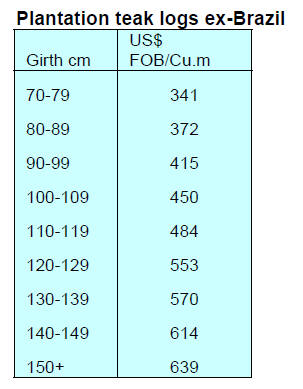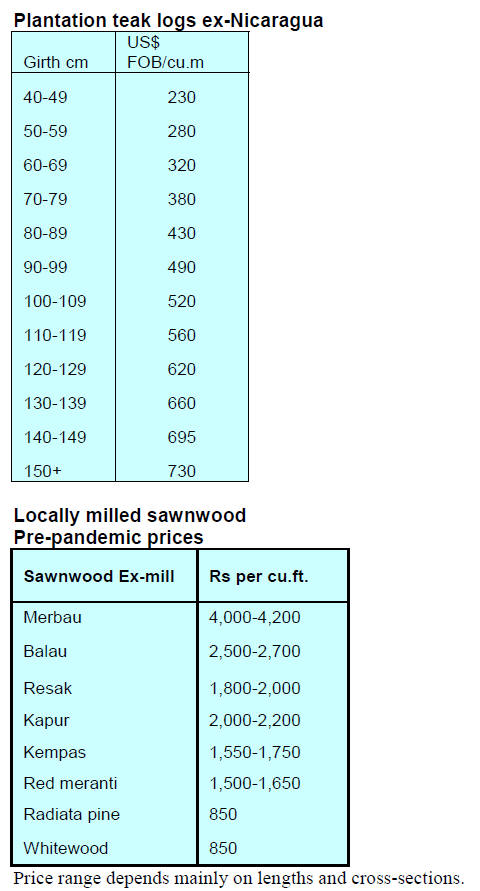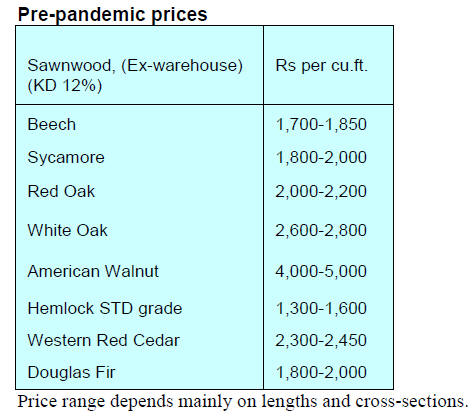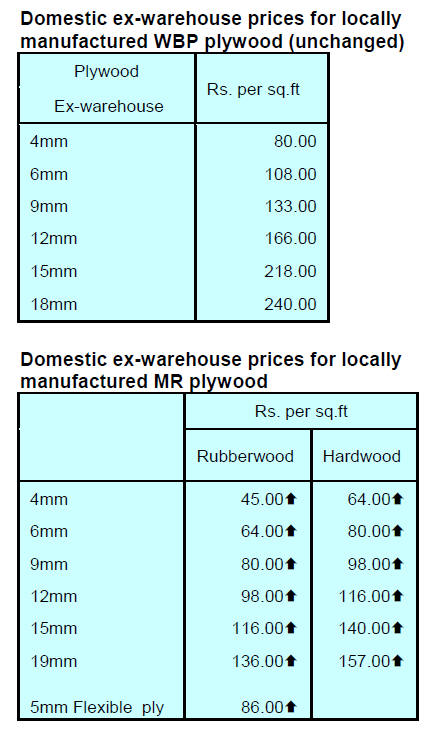4.
INDONESIA
Challenges for small-scale furniture
makers
Furniture and wood carvings produced in Jepara and its
surrounding area on the north coast of Java Island are
widely known for there unique designs and quality.
While over 90% of the carving producers are SMEs the
sector makes a big contribution to the economy. The
Jepara wood-processing sector generated exports worth
US$187 million in 2019. However, the rising demand for
wood raw material is having an impact on availability and
harvesting.
To ensure wood raw materials are sourced legally
Indonesia’s has its domestic Timber Legality Assurance
System (SVLK) and SMEs which comply have found this
boosts export opportunities. However, while the timber
sourcing may be legal many SMEs struggle to meet
government regulations on matters such as businesses
licencing.
Muhammad Suryadi from the Jepara Wood Artisans
Association (APKJ Asosiasi Pengrajin Kayu Jepara) has
urged the authorities to assist SMEs when they apply for
licence and tax registration and for such things as worker
insurance. With this completed the SMEs can secure
SVLK certification opening the chance for exporting and
creating opportunities to secure credit.
The results of an unpublished FAO/APKJ-CIFOR 2020
report of a study in Jepara and Pasuruan Regencies found
that many furniture SMEs were not SVLK certified. The
survey showed that only 9% of respondents in Jepara and
1.6% of respondents in Pasuruan were certified.
See:
https://forestsnews.cifor.org/70602/going-global-woodproduct-certification-requires-broad-legal-arena?fnl=en
A shift from contract to community group workers in
forestry
The National Economic Recovery programme is ongoing
and one aspect in the forestry and timber sectors is labour
intensive production through a community empowerment
strategy. The story of this effort has been captured in a
book "Pioneers at sites: Pioneers of National Economic
Recovery, Environment and Forestry."
This summarises the efforts of pioneers in peat and
mangrove conservation, forest food production,
community business and industry, traditional tourism.
The book highlights a new approach in managing forests
and forest areas in which there is a shift from contract
workers to community group workers.
In the book Dr. Siti Nurbaya, Minister of Environment and
Forestry forest is quoted as saying “communities have
strong anthropological, historical, religious and economic
relations with nature. Decisions on forests and forest areas
have strong impacts on these communities, both in terms
of benefits and disadvantages. Local wisdom will become
the basis of thinking and action for forest and forest area
management”.
See:
https://www.menlhk.go.id/site/single_post/3532/the-story-of-thepioneers-the-spearhead-of-pen-lhk-at-the-site-level

5.
MYANMAR
Myanmar, one step
closer to verifying the legality of its
timber
According to a press release from the Myanmar Forest
certification Committee (MFCC) an agreement has been
signed for a project “Strengthening SFM Standards and
Timber Legality Framework in Myanmar”. This two year
project funded by the Forestry Agency of Japan through
the International Tropical Timber Organization (ITTO) is
scheduled to commence 1 February this year.
The project will strengthen sustainable forest management
standards, the national forest management certification
system and the chain of custody for wood products in
Myanmar.
The project is designed to make the Myanmar Timber
Legality Assurance System (MTLAS) certificate more
functional and to expand its wider acceptance in
international markets. Another important element of the
project is to support the DTTS (Digitalized Timber
Tracking System) which will ensure traceability.
The Myanma Timber Enterprise (MTE) is already
implementing a QR code system. The project will support
the QR code system so that the current level of ‘Access to
Information’ will be promoted to the level of ensuring a
robust chain of custody along the supply chain.
MFCC is currently undertaking the necessary steps to get
the domestic national certification system (MFCS)
endorsed by PEFC. In addition, MFCC and PEFC are
discussing a synergy platform to meet the project outcome.
See:
https://myanmarforestcertification.org/itto-awards-a-projectto-mfcc/
and
https://www.itto.int/project/id/PP-A_56-342A
Myanmar says Dawei SEZ contract breached
The Dawei Special Economic Zone (SEZ) Management
Committee says it lost confidence in the consortium led by
a Thai construction company due to breaches of contract at
the mega project in southern Myanmar’s Tanintharyi
Region. The Italian-Thai Development Public Co. Ltd.
(ITD) announced that it received a notification of
termination of its concession agreement to develop “the
initial phase” of the SEZ from the management committee.
The long-delayed SEZ on the Andaman Sea aims to cross
the isthmus by road into Thailand via the Gulf of Thailand,
connecting the Indian and Pacific oceans. The SEZ lies on
the Japanese-led Mekong Southern Economic Corridor
which aims to connect central Vietnam, Cambodia and
Thailand to Dawei.
See:
https://www.irrawaddy.com/news/burma/myanmar-saysthai-firm-dawei-sez-breached-contract.html
Singapore tops FDI list in Myanmar in Q1
Singapore was the top source of foreign direct investment
into Myanmar in the first quarter of the current financial
year 2020-2021, according to the data released by the
Directorate of Investment and Company Administration
(DICA).Singapore companies mainly put investments into
urban development, real estate, power and manufacturing
sectors.
China was the second largest investor in the current
financial year at US$133.53 million from eight enterprises,
followed by companies in Thailand investing US$24
million in Myanmar. Additionally, Singapore emerged as
the second-largest foreign investor in the Thilawa Special
Economic Zone, after Japan.
See:
https://www.gnlm.com.mm/singapore-tops-fdi-list-inmyanmar-in-q1/
Second IMF emergency loan
The International Monetary Fund (IMF) has approved a
second emergency loan for Myanmar, worth around
US$350 million as Myanmar continues to suffer the
impact of the pandemic.
Last month, Myanmar’s government negotiated with
international development organizations, including the
IMF to secure more than US$950 million in order to
purchase vaccines.
Myanmar expects that 40% of its 54 million inhabitants
will be vaccinated by the end of 2021. The remaining 60%
are expected to be vaccinated during the 2022-23 financial
year.
Investors expect growth to accelerate in Myanmar
Investors expect business to return to normal in Myanmar
by the third quarter of this year with the technology, media
and telecoms sectors leading the way.
According to U Thaung Tun, Union Minister for
Investment and Foreign Economic Relations, the
Myanmar economy is expected to recover and reach
growth levels of as much as 7% this year.
He emphasised that the recovery will be supported by the
government’s Myanmar Economic Recovery and Reform
Plan (MERP) which will prioritise manufacturing and
services. He said civil service reforms and digital
transformation will also be implemented.
Reduced trade for first quarter of fiscal 2020-21
Myanmar recorded US$8.9 billion in trade in the first
quarter of fiscal 2020-21, US$2.5 billion less than the
same period of the previous financial year. The fall was
attributed to lower exports of natural gas, gems, garments,
fishery and other animal products. Imports also declined
with the country buying less raw materials for local
processing.
See:(https://www.mmtimes.com/news/myanmar-sees-reducedtrade-first-quarter-2020-21.html)

6. INDIA
Further signs of
economic recovery
In its January Bulletin the Reserve Bank of India (RBI)
said that the Indian economy is getting stronger and that
the worst may be over provided there is not another wave
of infections. The Bank has said high-frequency indicators
such as government spending, a rise in merchandise trade,
growing credit and high manufacturing activity in
December 2020 were signs of economic recovery.
The RBI slashed interest rates early last year to support the
Indian economy and has left rates unchanged in recent
months to avoid pushing up inflation. The rate of inflation
stood at 1.22% for December 2020.
See:
https://rbidocs.rbi.org.in/rdocs/Bulletin/PDFs/EBUL21012021_F5770050C073B4C99AD00DD0B520ABAAC.PDF
December dip in wood product price index
The Ministry of Commerce and Industry has reported that
the official Wholesale Price Index for the group ‘All
Commodities’ (Base: 2011-12=100) for December
increased by (1.40%) to 123.0 in December, 2020 from
121.3 for November, 2020.
In December of the manufactured products included in the
survey (16, including furniture) saw an increase in prices
whereas 6 in the group saw declines in prices. Among
those seeing declines was the category Wood and
Products of Wood and Cork.
The press release from the Ministry of Commerce and Industry
can be found at:
http://eaindustry.nic.in/cmonthly.pdf

Imports up for first time since February but
exports fall
A further sign of improving economic activity was the
December rise in the value of imports which rose for the
first time since February 2020. On the other hand, exports
were slightly lower than in November due mainly to
reduced shipments to the UAE and parts of Europe.
Exporters have said, while the domestic economy is
showing sure signs of recovery, the same cannot be said
for the global economy and that tough times lay ahead.
Pandemic created disruptive trends across all sectors
The need for home offices, home study and a need for
individual space has impacted peoples preferences and
driven demand for a multi-functional and convenient
furniture. This, coupled with the slowing international
trade and the ‘Make in India’ campaign as well as a rise in
e-commerce, has boosted the Indian furniture
manufacturing sector.
It has been estimated that the Indian domestic furniture
market could grow over 10% annually over the next 4
years and this will be driven by some key trends:
Changing consumer preferences: comfort and
functionality have become significant
Policy support for manufacturing: there has been
a major policy push by the government
Initiatives like ‘Make In India’ and ‘Vocal for
Local’ gave a boost to the furniture
manufacturing sector
Rise in e-retail for furniture
Rise in the rental furniture sector
Rise in manufacturing productivity from robust
logistics and supply chain infrastructure
See:
https://www.zeebiz.com/market-news/news-top-5-keytrends-manufacturing-and-retail-trends-that-will-drive-growthof-the-indian-furniture-sector-in-2021-146501
Plantation teak
The freight cost war continues with teak log exporters
anxious to get shipments away but importers reluctant to
commit to shipping due to freight rate volatility. The only
reliable guage of prices FOB prices which remain
unchanged.


Sawn hardwood prices
Traders report improved sales in the main provincial
markets where spread of the Covid virus has been less
severe in contrast to demand in the urban areas. Some
wholesalers are adding a freight top-up to their listed exwharehouse prices.

Plywood
The problem of finding an adequate numbers of workers to
maintain full production continues to be an issue
especially in mills in Kerala, Maharashtra and Orissa.
Wages are rising as are veneer prices and these are
undermining profitability. Plywood mills have raised
prices for locally manufactured MR plywood.

7.
VIETNAM
US$14 billion export target for 2021
At a recent press conference the Head of the Vietnam
Administration of Forestry, Nguyen Quoc Tri , said wood
and wood products exports topped US$13.22 billion last
year the highest in the history of the timber sector.
For 2021 the forestry sector export target is US$14 billion
and revenue from forest environmental services is
estimated at VND2.8 trillion. In 2021 there are plans, said
Nguyen Quoc Tri, to plant 230,000 hectares of forests,
comprising protection, special-use, and production forests.
See:
https://sggpnews.org.vn/business/forest-wooden-productspost-recordhigh-trade-surplus-90452.html
In related news, the Deputy Minister of Agriculture and
Rural Development, Ha Cong Tuan, has said over the next
five years wood and wood product exports should reach
US$20 billion.
In that five year period, he said, the sector will work to
sustain the forest cover at 42%, expand and diversify
markets, develop long-term trade partnerships and
promptly address international trade issues.
Vietnam now ranks fifth globally, second in Asia and first
in Southeast Asia in terms of wood and wood product
exports shipping to over 120 countries and territories
worldwide. Vietnam has more than 5,500 companies
operating in timber processing.
Decsion on Vietnam’s currency valuation practices
The US Trade Representative has issued findings in the
Section 301 investigation of Vietnam’s acts, policies, and
practices related to currency valuation, concluding that
Vietnam’s acts, policies, and practices including excessive
foreign exchange market interventions and other related
actions, taken in their totality, are unreasonable and
burden or restrict US commerce.
In making these findings, USTR has consulted with the
Department of the Treasury as to matters of currency
valuation and Vietnam’s exchange rate policy.
The findings in this investigation are supported by a
comprehensive report, which is on the USTR’s website.
The USTR is not taking any specific actions in connection
with the findings at this time but will continue to evaluate
all available options.
See: USTR Releases Findings in Section 301 Investigation of
Vietnam’s Acts, Policies, and Practices Related to Currency
Valuation | United States Trade Representative
8. BRAZIL
Well-directed support means a
recovery can take hold
quickly
Brazil has been one of the countries worst affected by
coronavirus and the pandemic continues to take a heavy
toll. Between January and November central government
spending rose around 40%. According to the Institute of
International Finance most of the money went on a flatrate
payment as temporary income for nearly a third of the
population.
This has put a heavy burden on public debt which now
stands at over 90% of GDP but analysts say Brazil can still
fund itself and that well-directed support to the economy
now will mean a recovery can take hold quickly when the
vaccine roll-out is completed.
Environmental services policy approved
After nine years of discussion in the National Congress
Federal Law No. 14.119/21 was finally approved on 13
January 2021 establishing the National Policy for Payment
for Environmental Services (PNPSA - Política Nacional de
Pagamento por Serviços Ambientais).
According to the law, Payment for Environmental
Services (PES) is a voluntary transaction between users
and suppliers whereby a payer transfers remuneration to a
supplier that performs activities that favor maintenance,
recovery or improving ecosystem services.
Contrary to most environmental standards, the PES is an
economic instrument for achieving environmental goals
and policies, encouraging desired behaviors and is thus
different from the usual command and control
mechanisms.
The full text in English can be found at:
https://www.cbd.int/financial/pes/brazil-pescases.pdf
Sindmóveis foresees growth for the Bento Gonçalves
furniture cluster
In a press release the Furniture Industry Association of
Bento Gonçalves (Sindmóveis) has said the furniture
sector anticipates positive prospects for 2021 and an
expansion of revenue of 4%.
In 2020 the pandemic disrupted the supply and production
chain in the state of Rio Grande do Sul and that demand
recovered faster than production resulting in low stocks
and higher prices for inputs.
The press releasealso says between January to September,
compared to the same period in 2019, exports grew by
8.9%, from US$26 to US$28 million. Colombia and the
United States were the highlights being among the top five
destinations for Bento Gonçalves furniture, in addition to
Saudi Arabia, Chile and Uruguay. There were significant
increases in shipments in the period to India, Ecuador,
Puerto Rico and South Africa. On the other hand demand
in traditional markets such as Argentina and Paraguay has
been falling throughout the year.
See press release:
http://www.sindmoveis.com.br/portal/en/imprensa/noticias/crescimento-nas-exportacoes-do-polo-moveleiro-de-bento-goncalves
November 2020 export update
In November 2020 Brazilian exports of wood-based
products (except pulp and paper) increased 22% in value
compared to November 2019, from US$245.1 million to
US$299.3 million.
November pine sawnwood exports increased 21% year on
year from US$39 million in 2019 to US$ 47.2 million in
November 2020. In volume terms exports increased
almost 30% from 206,200 cu.m to 267,600 cu.m.
Tropical sawnwood exports in November fell 7.3% in
volume, from 41,300 cu.m in November 2019 to 38,300
cu.m in November 2020. The value of exports also fell
dropping 19% from US$19.2 million in November 2019 to
US$15.6 million.
In contrast pine plywood exports saw a 78% jump in value
in November 2020 in comparison with November 2019,
from US$36.0 million to US$64.1 million.
In volume terms, exports increased 41% over the same
period, from 160,700 cu.m to 226,400 cu.m.
Tropical plywood exports declined in volume (-11%) and
but maintained the same value year on year from 8,400
cu.m (US$3.2 million) in November 2019 to 7,500 cu.m
(US$3.2 million) in November 2020.
Encouragingly, wooden furniture exports increased from
US$47.5 million in November 2019 to US$57.7 million in
November 2020.
December 2020 export update
In December 2020 Brazilian exports of wood-based
products (except pulp and paper) increased 47% in value
compared to December 2019, from US$222.3 million to
US$327.4 million.
Pine sawnwood exports increased 53% in value, rising
from US$ 34.8 million in December 2019 to US$ 53.2
million in December 2020. In volume terms exports
increased 371% from 213,500 cu.m to 292,800 cu.m.
In a reversal of data for November tropical sawnwood
exports in December increased 37% from 33,300 cu.m in
December 2019 to 45,700 cu.m in December 2020.
Exports earnings grew just over 8% from US$15.4 million
to US$16.7 million.
In December 2020 pine plywood exports continued the
upward trend rising year on year 83% from US$35.9
million to US$65.7 million. In volume, exports increased
39% from 168,200 (Dec. 2019) cu.m to 233,900 cu.m
(Dec. 2020).
Tropical plywood exports continued down dropping 13%
in volume from 7,600 cu.m (US$2.7 million) in December
2019 to 6,600 cu.m (US$2.7 million) in December 2020.
Wooden furniture exports rose once again in December
2020 from US$43.9 million in December 2019 to US$59.8
million in December 2020.
Furniture exports dropped but by much less than
expected
Given the decline in international demand the 2020
performance of Brazil’s furniture industry can be
considered positive as the cumulative decline in the value
of exports was just under 3%.
The year ended with export sales of US$691.3 million
(US$710.9 million in 2019). Out of the four largest
exporting states which account for 95% of total furniture
exports two reported growth (São Paulo 0.6% and Paraná
3.4%) while Santa Catarina (-1.5%) and Rio Grande do
Sul (-8.9%) did less well.
By market region, Latin American demand was a surprise
as it accounted for 31% of the total value of exports
despite dropping 9% compared to 2019.
North America was the top market taking 42% of the total
(up 8% year on year) followed by Europe with 16% share
but with a decline of 16%.
Wood-based panel exports to China increased in 2020
Fibreboard and particleboard exports showed some growth
in 2020, increasing 1.5% compared to 2019. However, for
the two largest consumers among the 155 countries that
purchased wood-based panels from Brazil, the United
States and China, there was an increase in exports. Exports
to China increased 51%, while sales to the United States
increased 24%.
Among the five largest importer countrie, accounting for
60% plus of total exports, only the US and China
registered an increase. The greatest fall was in Mexico, -
35%, according to the Foreign Trade Statistics
(ComexStat) from the Ministry of the Economy.


9. PERU
Optimism that vaccinations will
allow economy to
recover quickly
Peru has reported more than one million cases of
coronavirus since the pandemic struck in March. Cases
have crept up recently following the end-of-year holidays
creating a shortage of beds in critical care wards in Lima
and across the country. The President announced that his
administration had negotiated vaccine supply deals with
Sinopharm Group and AstraZeneca.
See:
https://andina.pe/ingles/noticia-perus-fin-min-economy-togrow-115-in-2021-828209.aspx
The Minister of Economy and Finance has said that
despite measures taken to reduce the surge of COVID-19
cases during the second wave of the pandemic which
began after the Christmas and New Year holidays, Peru's
GDP will recover this year after a downturn in February.
ADEX sees UAE as Middle East export gateway
Erik Fischer, ADEX Chairman and the Director of
the Association of Peruvian Exporters' Global Business
and Economy Research Center (Cien-Adex) recently held
discussions with the UAE Ambassador to Peru in order to
open the way for strengthening ties through investments
and bilateral trade.
The UAE, said Fisher, serves as a gateway to markets in
the Middle East and hopes progress will be made on a free
trade agreement.
See:
https://andina.pe/ingles/noticia-peru-exporters-interested-intrade-agreement-with-united-arab-emirates-831678.aspx
SERFOR launches satellite monitoring platform
The National Forest and Wildlife Service (SERFOR) has
introduced a real time system using satellite imagery to
monitor deforestation, logging activities and forest fires.
The new system monitors forests at the national level and
provides accurate and timely information through the
"Satellite Monitoring of Impacts to Forest Heritage",
managed within the National Forest and Wildlife
Information System (SNIFFS).
With timely and accurate information State institutions in
coordination with SERFOR can take immediate actions to
prevent, minimize and halt damage to the forest heritage.
As of the end of January the system has identified more
than 500 instances where follow-up investigation was
necessary.
Data delivered by the new system allows for the
estimation of potential monetary losses from deforestation
through economic valuation generated by the SERFOR
Inventory and Valuation Department.
Madre de Dios advances in its forest zoning process
The Department of Madre de Dios has expanded its forest
zoning process incorporating 24 fragile ecosystems over
an area of 205,028.10 hectares identified by (SERFOR).
This process was carried out in coordination with the
Regional Government of Madre de Dios, as well as local
governments, native communities and holders of
conservation concessions and ecotourism concessions.
With this inclusion established through Executive
Directorate Resolution No. D000106-2020-MINAGRISERFOR-
DE, Madre de Dios takes an important step in its
Forest Zoning effort.
Participation of women in the Peruvian forestry sector
In order to value the participation of women in the forestry
sector the Ministry of Agriculture through (SERFOR)
undertook a study “Challenges of female employment in
the forestry sector: a first approximation”. This was
supported by the German Development Cooperation.
Based on testimony from women the report describes the
situation of women who work in the forestry sector and
their difficulties in participating fully. The report
concludes with policy proposals for improving working
conditions and efforts to alert institutions in Peru aware of
problems women face.



